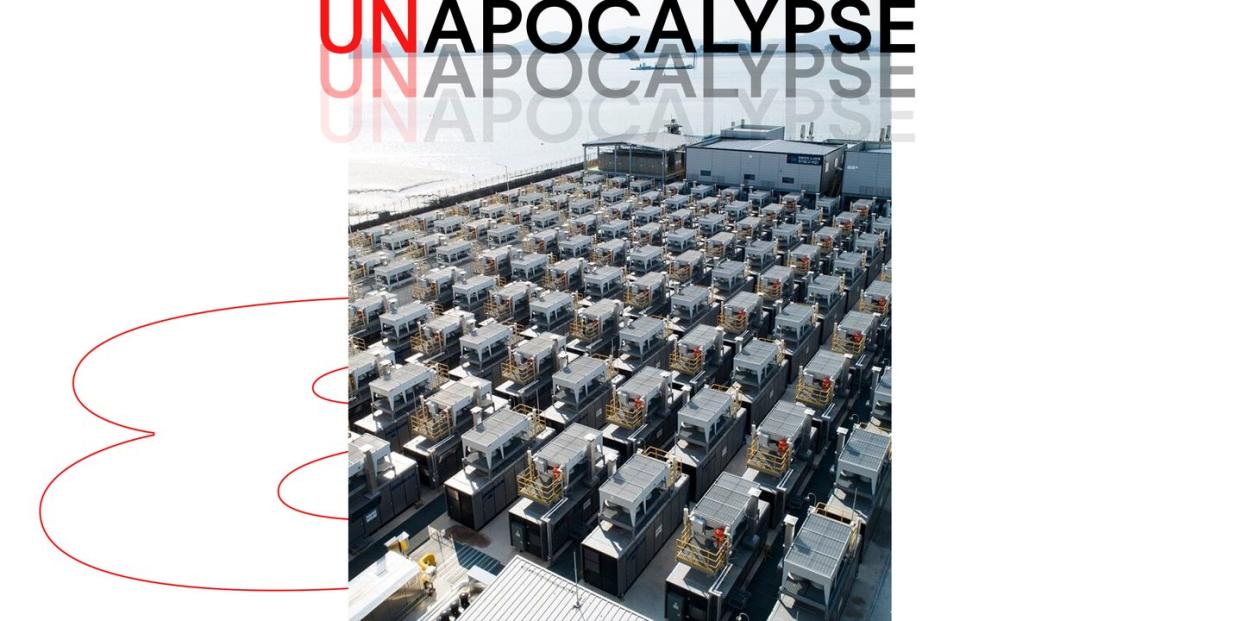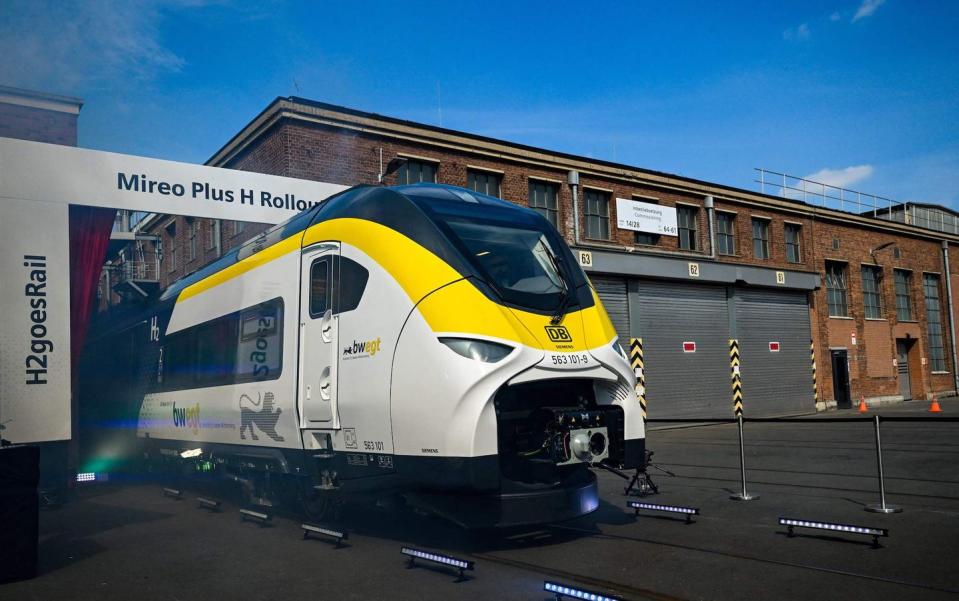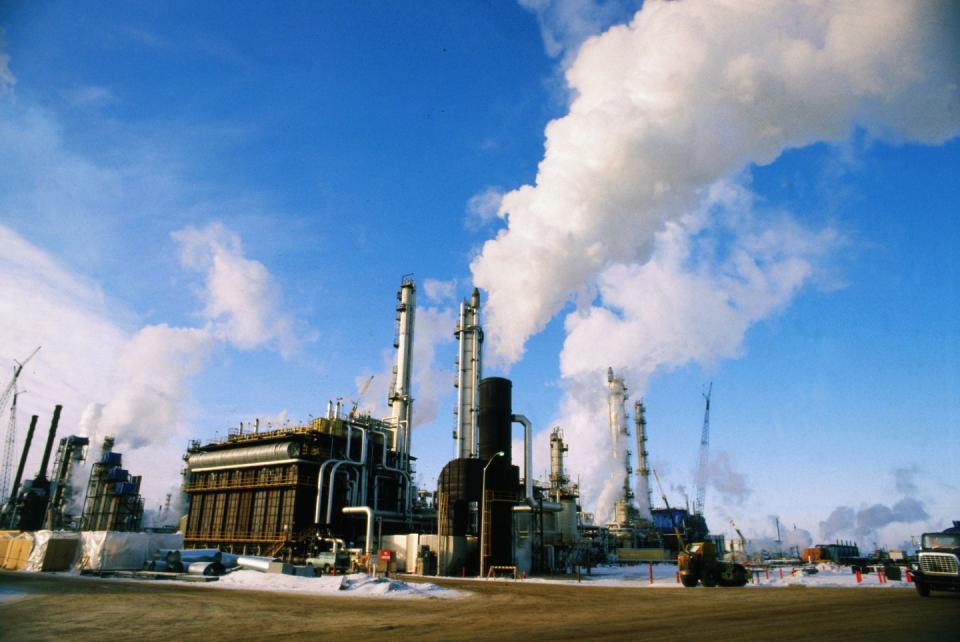The Most Abundant Chemical in the Universe Could Become a Hot Commodity

We’ve heard an awful lot of awful news when it comes to the climate crisis. But there are also very smart people working on clever ways for us to dig ourselves out of the hole we’re in. UNAPOCALYPSE is a series from Esquire that highlights ways humans can mitigate and adapt to the damage caused by a changing climate.
You can find last week's edition here.
What if I told you we could power our cars with the most bountiful element in the Universe? Is that something you might be interested in? One piece of our energy future is hydrogen (not to be confused with hydropower), which is already the source of fuel for 50,000 forklifts in warehouses across the United States. Hydrogen fuel cells are also a growing feature for road vehicles, and their proponents hope to see them make their way into bus and trucking fleets over the coming years. After all, these fuel cells are like batteries you don’t have to recharge. You just put more hydrogen in, like gasoline—except what comes out of your tailpipe is only heat and water vapor. It’s completely clean energy when it’s made using power from other renewable sources, and it’s modular: You can stack as many fuel cells as you like to adjust your power output to the task at hand.
“Green hydrogen” does have a cost problem, because it’s produced via a process called electrolysis, which is essentially the opposite of the process that fuel cells use to create electricity. (This loop will allow hydrogen to serve as a kind of battery for other forms of energy, not unlike “pumped storage” hydropower.) Right now, using wind or solar, the cost per kilogram of hydrogen is $4 or $5. The Department of Energy has just announced the 1:1:1 initiative to rally government and industry to get costs down to $1 within one decade. Essentially, we need to create a viable and stable market for this new technology and turn hydrogen into a hot commodity. If we can, and if we can build out our hydrogen infrastructure with refueling stations and the supply chains to match, these fuel cells have the potential to compete with the battery-powered electric cars that are already popping up all over America’s roads. They will certainly be highly competitive when it comes to trucking.
Plus, hydrogen has potential as a source for electricity in our homes: South Korea opened a hydrogen fuel cell plant last year—the world’s largest—that will supply power to 250,000 households annually. It will also reportedly function as an air purifier for the surrounding area, sifting fine dust from a nearby natural gas plant, and it will produce hot water to heat 44,000 households. South Korean plants often use hydrogen produced as a byproduct of chemical manufacturing, which is cheaper than producing hydrogen from water by splitting it from the oxygen using electrolysis. That’s still quite rare in South Korea, which is only just turning its focus to producing green hydrogen. In Japan, meanwhile, there are 400,000 residential fuel cell units helping to power individual homes.
For a look at the opportunities and obstacles around hydrogen fuel cells, I spoke with Sunita Satyapal, director of the Department of Energy’s Hydrogen and Fuel Cell Technologies Office. Our conversation has been edited for length and clarity.
What are the basics of generating power from hydrogen using fuel cells?
In general, the way the fuel cells work is you have a fuel, in this case hydrogen, and it flows on one side of the fuel cell. The fuel cell itself consists of a membrane and catalyst, and the hydrogen flows on one side and then you have air that flows in on the other side, and it produces electricity just like a battery, but you never need to charge the fuel cell. As long as you have air that's flowing in and hydrogen, it produces electricity. It's very modular, it's scalable, so you can use it in many different applications, like transportation or stationary power. And so it's very flexible, and there's completely zero emissions: The only product that's emitted is water vapor.
You mentioned that you never really have to recharge them as you would a battery. What does that look like in a vehicle?
Another benefit of fuel cells, just like batteries, is electric drive. You have an electric motor, you don't have an engine like a typical gasoline or diesel engine. And the reason fuel cells are so efficient is that you don't waste a lot of energy. In today's vehicles, you have an engine which burns the fuel, so you have a very high temperature and you waste a lot of energy. Basically you have a flame in your vehicle in conventional combustion gasoline engines.

And so [with hydrogen fuel cells], it's similar to battery electric vehicles, [in] that you just produce electricity directly. And the difference is that the engine is replaced. I don't know if you've seen the commercial [hydrogen fuel cell vehicles] that are available, but the actual power that's needed is pretty compact. Depending on the type of vehicle, it's only about a couple of feet long and maybe a foot wide and deep, so that replaces the engine. And then you have hydrogen that's stored also on board, typically it's just a gaseous hydrogen in a tank, and it takes just a couple minutes to refuel. You just fuel it just like you fuel gasoline, and the vehicle can go. Right now the commercial vehicles can go over 300 or 400 miles, depending on the type of vehicle.
Our focus especially is on long-haul trucks. We're looking at the entire portfolio: batteries, other liquid fuels and then of course, hydrogen. And one of the benefits is that you can get a really long driving range, you don't need a really large battery, and it doesn't take that long to recharge, so you don't have to plug it in. For some of the transit agencies that have a couple hundred buses, you don't need to plug them in, you can just refuel like today's gasoline vehicles, but with hydrogen.
It seems like there are a lot of advantages here. What are the obstacles?
One is the cost, both in terms of the cost of the hydrogen and then the cost of the fuel cell, the storage and so forth. And the second challenge is the infrastructure, the number of stations and distributing the hydrogen to the stations. Those are some of the key barriers.
We launched an initiative called Hydrogen Shot. You may have heard of the Energy Earthshots, similar to over half a century ago, when we had the Moonshot of getting a human being to the moon. These Energy Earthshots are meant to be really bold, ambitious goals for the entire community. This easily articulated goal for Hydrogen Shot is 1:1:1—that stands for $1 for 1 kilogram of hydrogen in one decade. Today the cost—if you make hydrogen from renewables like solar and wind—can be about $4 or $5 per kilogram. So we're going from $5 to $1, and that will help to increase widespread adoption. We're also focusing on the cost and the durability of the fuel cell, as well as efficiency and performance.
Finally, we also just announced last week our National Hydrogen Strategy and Roadmap for the U.S. We also announced a funding opportunity for hydrogen hubs. The idea is to produce large-scale hydrogen and then have multiple end-uses, not just transportation. You can use hydrogen for industrial applications, like making steel and fertilizer, and power generation. That will help to get the market going, market adoption, and will also help the transportation sector, if we can get it to scale. There are very few manufacturing plants, in terms of the supply chain for some of the components. It’s still a very early industry.
Over a decade ago, you may remember the Recovery Act that funded the niche application of forklifts. There was a need to have zero emissions in warehouses, and it was difficult to have batteries because there wasn't enough time to recharge, especially if you had multiple shifts. And we funded some of the early demonstrations, and now there are over 50,000 hydrogen fuel cell forklifts operating inside warehouses, and they're major companies like Amazon, Walmart, Home Depot. So it's starting to become more widespread for certain markets.
I've read that the platinum that's involved in this can be harder to procure, too.
The system to produce hydrogen from renewables is called an electrolyser. Depending on the type of technology, you may need platinum or platinum-type metals. Our funded research already reduced the cost, reduced the amount of platinum significantly. And the goal is to have less platinum than in today's cars. [In] your catalytic converter, you also have platinum metal. The goal is to reduce the amount of platinum and then also design for recovery and recycling, so we would be able to replenish the platinum. But that's one of the key cost challenges.
Do these systems face any problems with the elements, like hot and cold weather?
More than a decade ago, we had a national hydrogen fuel cell learning demonstration project: over 250 vehicles and 30 stations, and tested fuel cells and vehicles under different climate conditions and altitudes and so forth. There was really good performance even at low or high temperatures. We still need to do more long-term testing on durability and so forth, but so far, very good performance.
I also wanted to ask you about power plants. South Korea just built the world’s biggest hydrogen plant, and they're actually using hydrogen recycled from chemical manufacturing?
I think it was over 75 megawatts. This is a good example of another application of fuel cells—it's not just for transportation but for stationary power. For small residential, Japan has roughly 400,000 fuel cells [at individual properties]. South Korea, as you mentioned, has large stationary fuel cells. These can be either low temperature, or they can be high temperature and provide heat as well. You can use it for combined heat and power.

And one of the advantages is also resiliency, so if the grid goes down, you have power. In fact, the new World Trade Center has fuel cells. They can provide backup power and turn on only when there is a power outage—we have hundreds of these at remote cell phone towers in case they lose power. Or they can just keep running and provide continuous, reliable power. You can also operate them on natural gas, you don't have to have hydrogen. Especially in remote communities, it's zero emissions and very quiet operation.
Where do you hope to see this technology at the end of the decade? What would your ideal scenario look like?
For our national goals, as you know, we include net zero by 2050, a completely clean grid by 2035. We have huge goals. And many people call hydrogen the Swiss army knife of energy, because you can produce it from so many different resources. So you can use renewables like solar and wind, and then you can produce hydrogen. You can store that hydrogen so you can use it when you don't have sun or wind. You can use nuclear—clean—electrons to produce the hydrogen. Our goal within a decade is to get to $1 for hydrogen, that would be huge. We'd be able to produce completely clean hydrogen at really low cost. And then we would have our hydrogen hubs. We have a billion [in funding] now, specifically in the bipartisan infrastructure law. We have tax credits now in the Inflation Reduction Act. The goal within a decade is to get to 10 million tons of hydrogen in the U.S. That's clean hydrogen, about 10% of the global capacity.
Coming up on October 8th is National Hydrogen Day. Hydrogen is the most abundant element to the universe—it's actually element number one—and the atomic weight is 1.008, so 10/08 is designated National Hydrogen and Fuel Cell day, because many people don't know about hydrogen or fuel cells, they know about solar, wind, batteries. Part of the challenge is just public awareness and knowledge about hydrogen and fuel cells.
You Might Also Like

